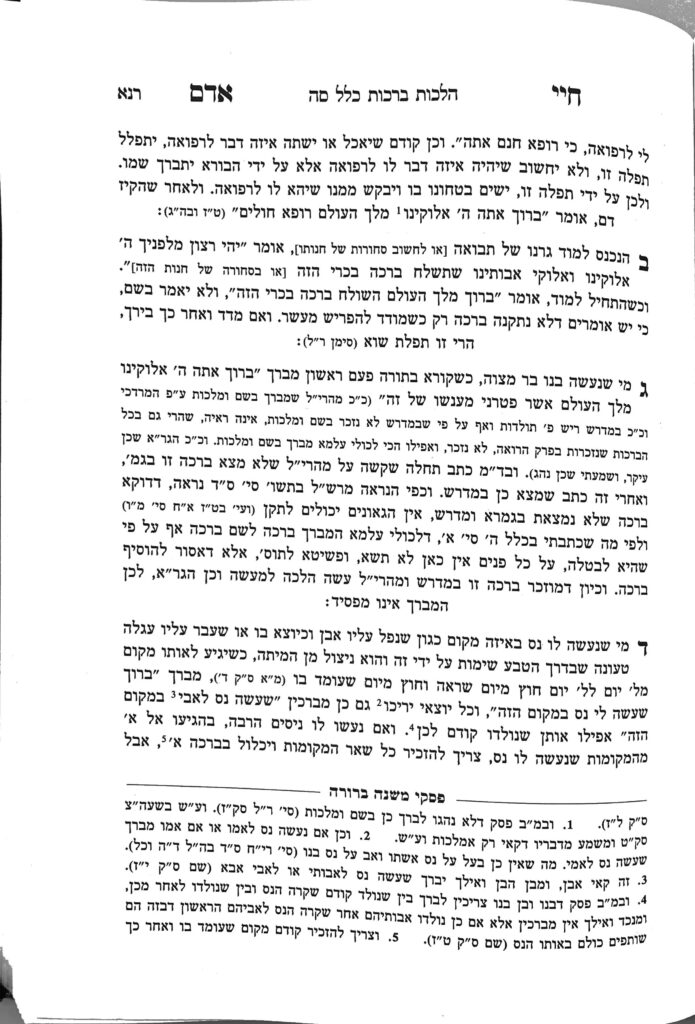We are continuing in siman 3, where the Chayei Adam discusses the bracha of baruch shepitrani. We learned that the question regarding reciting the bracha surrounds whether the Geonim and Rishonim have the power to institute brachos which are not mentioned in the Gemara. We learned that the Maharshal paskened that a bracha which is mentioned in secondary sources of Chazal, such as the Midrash, can be instituted as a bracha by later authorities, but if there is no mention whatsoever, it cannot be instituted by later authorities. In other words, Chazal would not institute a bracha in a Midrash, because if they felt the need to institute it as a bracha, they would have written it in the Gemara. Therefore, we would not be able to make a bracha based on a Midrash alone. However, if the Geonim came along and instituted a bracha, they can use the Midrash as a source to their bracha.
The Maharshal’s psak addresses the bracha of baruch shepitrani, which is mentioned in the Midrash in Parshas Toldos, and other brachos which have sources in Chazal. However, it does not address the bracha of hanosein la’yaeif koach, which is not mentioned in the Gemara nor the Midrash, and is a takanas haGeonim.
One theory is that the bracha of hanosein la’yaeif koach did exist in the original texts of the Gemara, but got lost over time. Although it is certainly possible, there is no definitive proof to this theory.
In Siman 46:6, the Shulchan Aruch writes that one should not recite the bracha of hanosein la’yaeif koach. The Rema writes that the minhag is to recite it nonetheless. The Magen Avraham, quoting the Kenesses Hagedolah, writes that the Shulchan Aruch changed his opinion later in his life, and held that one should recite this bracha.
The Taz suggests that the reason we are able to recite this bracha, even though it is not mentioned in Chazal, is due to the concept of minhag mevatel halacha, minhag can override halacha, a concept introduced by the Yerushalmi. Obviously, the Yerushalmi does not mean, for example, that one can create a “minhag” to break Shabbos. Some understand that the Yerushalmi refers specifically to monetary law, in that the local precedent (i.e., minhag)–both as it is written in a contract and as it is implied by the local standard–will override a standard as it may be brought in halacha.
The Gra, on the bracha of hanosein la’yaeif koach, understands that the concept of minhag mevatel halacha applies differently here. He understands that there is no issur to make a bracha not mentioned in the Gemara (similar to the Chayei Adam, who holds that one transgresses the issur of lo sisa). Rather, the reason we do not create brachos that are not mentioned in the Gemara is simply because we do not have the power to do so. However, once the minhag has become established as such in Klal Yisroel, it is not wrong to recite it, and the minhag will allow for the bracha to be recited.
It is not clear what the Gra himself held regarding such brachos. Although he writes this idea both regarding hanosein la’yaeif koach and baruch shepitrani, in the sefer Tosefes Maaseh Rav, which records various minhagim of the Gra, it is written that the Gra did not recite the bracha of hanosein la’yaeif koach. However, Rav Moshe Shternbuch, in his sefer on Tosefes Maaseh Rav, writes that it seems the opinion of the Gra is in accordance with his glosses on Shulchan Aruch, and that he would recite both the bracha of hanosein la’yaeif koach and baruch shepitrani, along with the bracha of she’asani kirtzono (for his female family members) and mekdeish es shimcha barabim.
In a similar vein, two other brachos we mentioned, someich noflim and magbiah shefalim, are not recited, because the minhag never took root to recite them.
This idea also explains a bracha brought down by the Shulchan Aruch (in Even Haezer, siman 63). He held that it had become the minhag to recite that bracha, even if he held it had not become the minhag to recite the brachos of baruch shepitrani and hanosein la’yaeif koach.
Summary
- There is a machlokes whether brachos which are not found in the Gemara can later be established as bona fide brachos or not.
- If the bracha has a secondary source (e.g., Midrash), we may recite it. Thus, for example, the Chayei Adam writes that Baruch Shepitrani may be recited with Hashem’s name. (We will continue to discuss other reasons whether it can be said)
- Even if the bracha does not have a source in Chazal, if the minhag has become to recite it, we recite it. Thus, for example, we recite the bracha of hanosein la’yaeif koach, even though there is no source in Chazal for the bracha.



